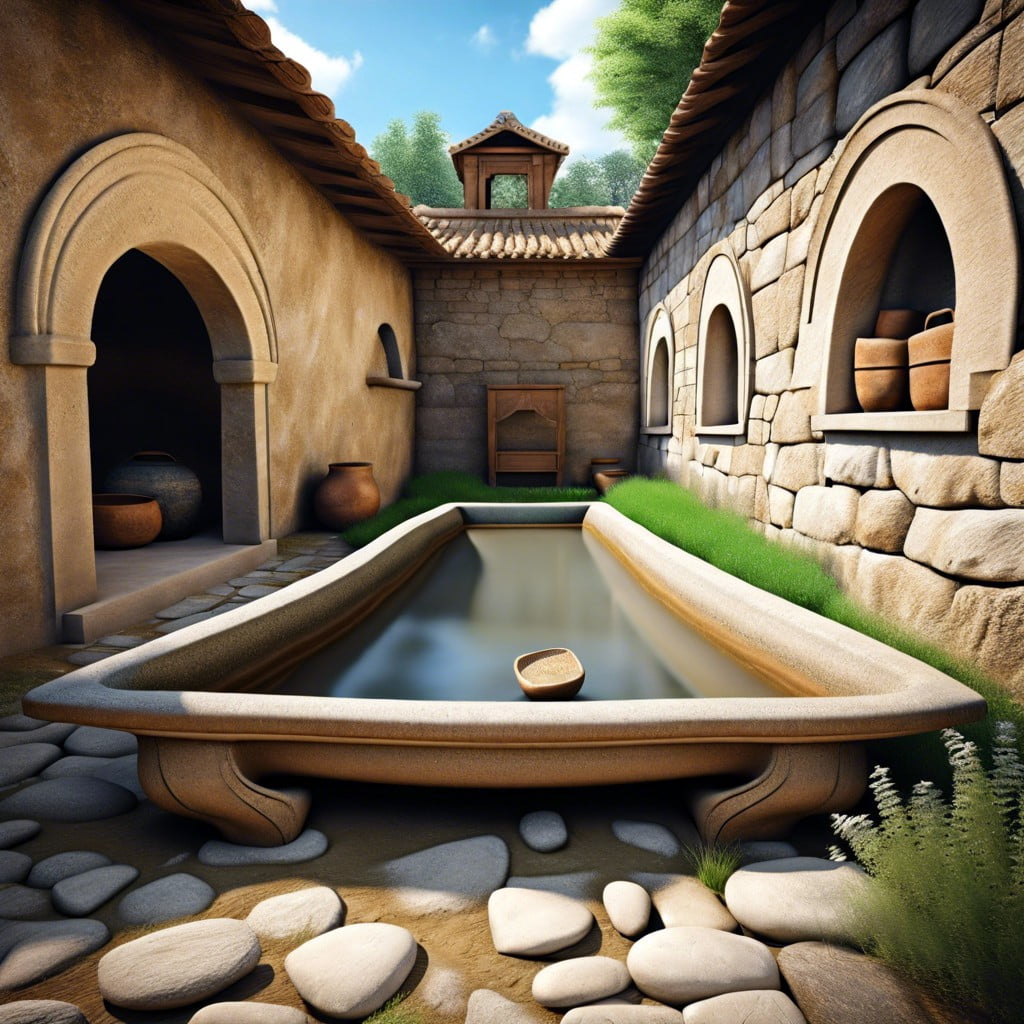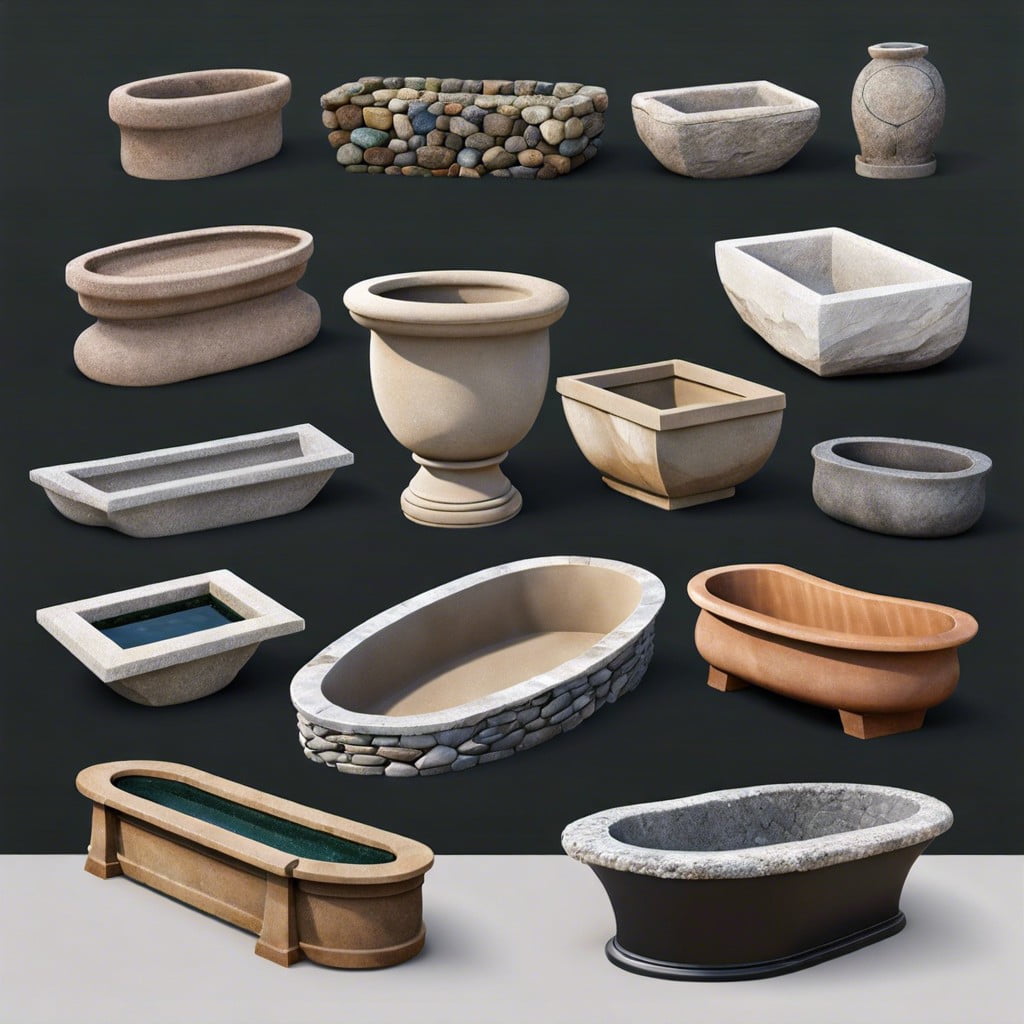Last updated on
Delving into the world of antique stone troughs becomes an enchanting journey because of their unique beauty and compelling history, both of which find modern relevance in gardening and landscape design.
Key takeaways:
- Stone troughs have historical significance in agricultural practices.
- Different types of stone, such as granite and sandstone, are commonly used.
- Stone troughs served multiple functions in agriculture, from watering livestock to processing harvests.
- Stone troughs are culturally important in gardening, adding rustic charm and enhancing biodiversity.
- Maintenance and care are important to preserve the beauty and functionality of stone troughs.
Historical Significance of Stone Troughs

Stone troughs have an enduring legacy, often dating back centuries, which reflects the agricultural practices of earlier societies. They were primarily used for watering livestock, soaking seeds before planting, and washing crops post-harvest.
These troughs, shaped from durable materials like granite, slate, or sandstone, have witnessed the ebb and flow of daily rural life and have been fundamental in community settings, such as marketplaces and village squares, serving multiple communal purposes beyond agriculture.
Their robust construction has allowed many to survive to this day, providing a tangible connection to the past and a testament to the stonemasons’ skill. Additionally, these artifacts serve as an inspiration for contemporary garden design and architecture, echoing the ancient balance of form and function.
Types of Stone Used in Troughs

Varieties such as granite, slate, and sandstone are commonly chosen for their durability and natural beauty.
Granite, in particular, is prized for its hardness and resistance to weathering, making it an ideal material for outdoor use.
Slate offers a smoother texture and often features attractive color variations.
Sandstone, being somewhat softer, is easier to carve but can still withstand the elements when properly maintained.
Limestone is another option, valued for its classic appearance and relatively consistent coloration.
Each type of stone possesses unique characteristics that influence its appearance over time, with patinas developing that can add to the trough’s aesthetic appeal.
These stones are typically sourced from quarries and may be reclaimed from older structures to contribute an authentic, aged look to garden and landscaping projects.
Traditional Uses of Stone Troughs in Agriculture
In agricultural practices of the past, stone troughs served as indispensable tools for farmers:
- Watering livestock: These troughs were primarily used to hold water for cattle, sheep, and other farm animals, providing a robust and durable source of hydration.
- Mixing feed: Farmers relied on the troughs to mix and serve feed to their animals, leveraging the stone’s resistance to wear and ease of cleaning.
- Grain and crop storage: Smaller troughs occasionally acted as temporary storage for grains and other harvested crops, protecting them from rodents and the elements.
- Processing harvests: Some troughs were used to wash or sort produce like vegetables and fruits, benefiting from the stone’s natural ability to withstand the outdoor environment.
By understanding these traditional roles, one gains insight into the multi-functional nature of stone troughs in agricultural life. Even today, their historical utility imparts inspiration for their current applications.
Cultural Importance of Stone Troughs in Gardening
Stone troughs have long served as more than just utilitarian objects; they embody a rich horticultural tradition. Gardeners often view these pieces as historical artifacts, infusing a sense of the past into contemporary landscapes. They are prized for their rustic charm and robust aesthetic, effortlessly transforming garden spaces into visual narratives that speak of a time when these vessels were central to daily rural life.
In many cultures, incorporating stone troughs into gardens is seen as a nod to sustainable practices, continuing the ethos of reusing materials. Additionally, their unique, weathered appearance provides an ideal backdrop for a variety of plants, contrasting with the vibrant hues and soft textures of alpines, succulents, and small perennials. The use of these troughs often enhances biodiversity by creating microhabitats within the garden.
Furthermore, the art of planting in stone troughs carries with it a philosophy of working with natural materials, encouraging gardeners to consider factors such as drainage, soil composition, and plant suitability, all of which foster a deeper engagement with the gardening process. To summarize, these historical objects serve as functional, aesthetic, and ecological additions to the garden, bridging the past with present gardening philosophies.
Preservation and Restoration of Antique Stone Troughs
Understanding the importance of retaining historical character while ensuring structural integrity is crucial in the preservation of antique stone troughs. Often, these pieces have weathered the elements, resulting in a patina that reflects their age and history. To preserve this aesthetic:
- Gentle Cleaning: Use soft brushes and mild, pH-neutral cleaners to avoid damaging the stone. High-pressure washing or harsh chemicals can erode surfaces and strip away historical value.
- Repairs: Epoxy resins can be used to mend cracks without compromising the trough’s appearance. Match the stone’s color and texture as closely as possible to maintain authenticity.
- Stabilization: Address any structural issues that might lead to further deterioration. This might include reinforcing the base or correcting any tilting that has occurred over time.
- Protection from Weather: Consider the placement of the trough; excessive water or frost can hasten decay. Covering the troughs during extreme weather can prolong their life.
- Regular Inspections: Simple, routine checks can help catch and rectify small issues before they become major problems.
- Professional Advice: When in doubt, consult with conservation experts who specialize in historic artifacts to ensure the restoration approaches do not devalue the trough.
Implementing these steps helps to ensure that antique stone troughs can continue to be appreciated for years to come, bridging the gap between past and present.
The Process of Carving Stone Troughs
Carving a stone trough begins with selecting an appropriate type of rock. Traditionally, durable stones such as granite, sandstone, or limestone are chosen for their ability to withstand wear and weathering.
Once a stone block is sourced, the following steps outline the carving process:
- Designing: Artisans decide on the size and shape of the trough, often based on its intended use.
- Rough Shaping: Using hammers and chisels, the stone is initially shaped into a rough outline of the final product. This involves removing large, unnecessary pieces of stone.
- Detailing: Finer tools are employed to refine edges and smooth surfaces. For a trough, the artisan carves out the central cavity meticulously to ensure it is hollow and able to hold water or soil.
- Finishing: Surface finishing gives the trough its final appearance. Techniques such as sanding or polishing may be used, depending on the desired aesthetic. However, a rugged look is often preferred for its traditional and natural appeal.
- Drainage: Especially for garden troughs, drainage holes are added at the base to prevent waterlogging.
Artisans need expertise in stone masonry and a deep understanding of the stone’s properties, as different stones require varied techniques. Patience is essential throughout this process, with a single trough often taking several days to complete.
Modern Uses for Stone Troughs in Landscaping
Adapting to contemporary outdoor design, stone troughs serve multiple functions while adding a touch of timeless elegance. Incorporating these historic elements can enhance gardens and landscapes in a variety of ways:
1. Planters: A popular application in modern landscaping, stone troughs make unique planters that offer excellent drainage and durability, ideal for both flowers and edibles.
2. Water Features: Utilized as basins for fountains or miniature ponds, they create serene water features that attract wildlife and provide a calming auditory backdrop.
3. Outdoor Seating: With the addition of a sturdy top, larger troughs can be transformed into rustic stone benches, blending seamlessly with natural surroundings.
4. Architectural Accents: Acting as statement pieces, they can anchor garden designs, drawing the eye and providing structure to the landscape.
5. Heritage Gardens: For those seeking to create a historical or period-themed garden, stone troughs serve as authentically aged centerpieces that root the design in historical context.
Each use of a stone trough not only pays homage to the past but also contributes functional and aesthetic value to modern garden aesthetics.
Sourcing Authentic Antique Stone Troughs
Antique stone troughs, often sought after for their historical charm and uniqueness, can be sourced from a variety of places:
1. Specialty Antique Shops: These stores often curate a selection of garden antiques, including stone troughs, providing assurance of authenticity.
2. Architectural Salvage Yards: These yards rescue artifacts from buildings and landscapes that are being demolished or renovated. Here, you may find troughs with a rich history.
3. Auctions and Estate Sales: Such events can be treasure troves for antique collectors. They occasionally list stone troughs among other garden and estate pieces.
4. Online Marketplaces: Websites and online forums dedicated to antiques can be valuable resources, though verifying authenticity from a distance can be challenging.
5. Local Farms or Estates: Older properties may have stone troughs that are no longer in use, and owners might be willing to part with them.
When sourcing, it’s important to examine the piece for hallmarks of age, wear, patina, and provenance to ensure it’s a genuine antique. Engaging with knowledgeable sellers or using professional appraisers is advisable to verify an item’s authenticity. Additionally, obtaining a history of the trough, if available, can add to its value and appeal.
Understanding the Value of Antique Stone Troughs
Antique stone troughs are considered valuable for several reasons. Their age and rarity often contribute to their worth, as older troughs may have historical significance or showcase craftsmanship that has become less common. Additionally, the patina developed over years of exposure to the elements can add to their aesthetic appeal, making them sought-after decorative pieces.
Factors influencing their value include:
- Provenance: A well-documented history can increase a trough’s value, especially if it’s linked to a specific historical event or belonged to a notable estate.
- Condition: Troughs that have maintained their structural integrity over time, without significant damage, are generally more desirable.
- Authenticity: Genuine antique troughs, as opposed to modern replicas, command higher prices, so verification of authenticity is crucial.
- Size and Shape: Unique or particularly large troughs often attract more interest, potentially enhancing their market value.
- Cultural Significance: Troughs from regions known for stone craftsmanship may be more valued for their cultural heritage.
- Aesthetic Quality: Those with exceptional craftsmanship, design, or unique features can be considered works of art.
Understanding the interplay of these factors can help in assessing the true value of an antique stone trough.
Maintenance and Care for Stone Troughs
Caring for stone troughs extends their life and enhances their aesthetic appeal. Here are maintenance guidelines:
1. Regular Cleaning: Brush away debris with a soft-bristle brush. Use mild soap and water for a gentle wash, avoiding harsh chemicals that can erode stone.
2. Winter Care: Prevent water from accumulating and freezing in troughs, as this can cause cracking. Ensure adequate drainage or cover during colder months.
3. Algae and Moss Control: While some prefer the natural patina, control overgrowth by exposing stone to sunlight and improving air circulation.
4. Sealing: Consider applying a breathable sealant to protect against stains and water damage without trapping moisture.
5. Stabilization: Ensure the trough is level to avoid undue stress on any one side that could lead to cracks or breakage.
6. Minor Repairs: Fill small cracks with a stone epoxy or mortar that matches the color and texture of the original stone to maintain appearance and structural integrity.
7. Professional Advice: For valuable or historic troughs, consult a conservation expert before undertaking any significant repair or maintenance work.
Regular attention will uphold the integrity and beauty of stone troughs while allowing them to remain functional and attractive features in any setting.
Related:




